Table of Contents
- Types of Underwater Photography
- What Equipment Do You Need for Underwater Photography?
- The Best Cameras for Scuba Diving Photography
- Where Can You Conduct Underwater Photography Techniques?
- Basics of Underwater Photography Techniques
- How to Edit Underwater Photographs
- Underwater Photography Techniques Tips
- First-Time Advice For Underwater Photographers
- Create Your Photography Portfolio Website
Preparation in this kind of photography is more critical than in any other genre. Because shooting in water is much more complex than on land. Before diving, you should:
- Imagine what you want to shoot
- Decide at what depth you will photograph
- Prepare the equipment
- Install underwater camera set-up
Underwater photography is always stunning and also challenging. You need to have suitable camera modes, quality equipment, and reliable protection. Since water is much dirtier than air, it complicates the process of photography.
Besides, it requires special underwater photography techniques. And for the photos to be truly professional, you need to organize this process carefully. Thus, if you are new to underwater photo style, familiarize yourself with its basics.
In the following sections, we will tell you about this process's details and nuances. You will learn about the best settings for underwater photography, their types, and photo editing. And we also motivate you to dive even more into the topic of underwater images.
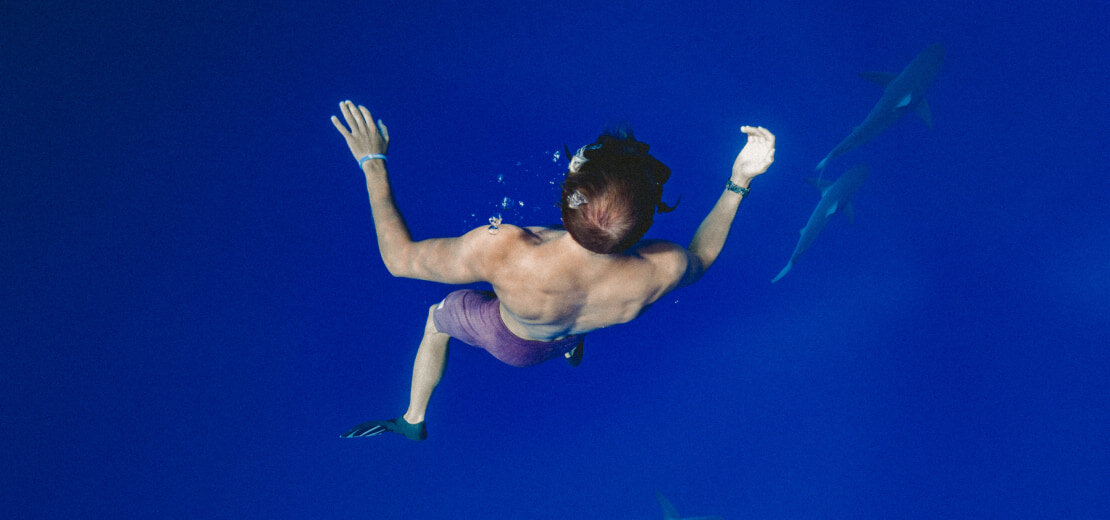
Types of Underwater Photography
Underwater photography is a genre you don't come across every day. The opportunity to make something creative underwater is very tempting. It is experience, adrenaline, and a touch of art. All the emotions a person feels during such a photo session will remain in the photos. But a lot also depends on the type of shooting. There is so much underwater equipment to create any kind of picture. They include such types of underwater photography:
1. Fashionable photo session
This is a style of photography that involves a model and a professional photographer. As for the photographer, they should use the best camera for scuba diving photography. After all, the model should be clearly displayed in the frame. And you need to see all the extra details in the lens.
2. Wild nature photo session
Oceans and seas are home to many marine animals and fish. And to create their shot, immerse yourself in underwater photos of the wild world. It requires a lot of underwater camera set-up. After all, some sea creatures can be dangerous. So, you should organize the process of photographing to minor details.
3. Macro photo session
If you get a kick out of tiny organisms of the underwater world, this type of shooting is for you. It involves photographing the most miniature underwater objects. For this, you need a special camera with macro mode. It can take pictures of even those sea creatures you can not see with your eyes.
4. Wide-angle photo session
Have you seen photos of old submarines on the Internet? Have you seen pictures of the underwater world in encyclopedias? All this is the result of landscape underwater photography techniques. You need to use a wide-angle lens and special lighting to do this. Combining these devices allows you to create incredible shots in the sea or ocean.
5. Scientific photo session
Sometimes we can watch underwater photos on the news or research programs. It is a scientific type of photoshoot that requires special underwater photography techniques. Scientists do it to study what is happening underwater due to climate change. Also, they can take pictures of underwater penguins, glaciers, etc.
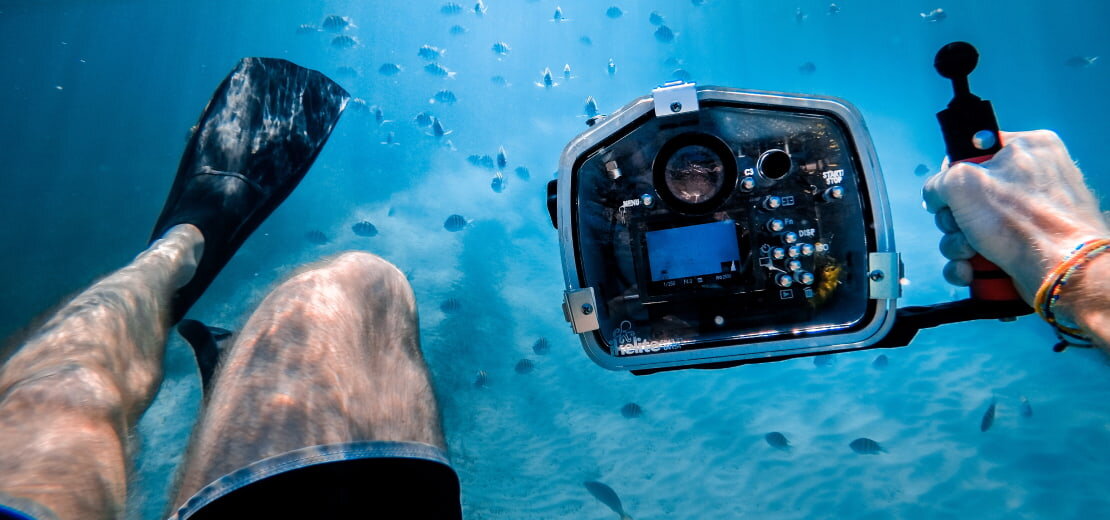
What Equipment Do You Need for Underwater Photography?
Nothing is better than diving into clean water, and photographing everything that happens there. And if you capture all this on video, the impressions will last a lifetime. So, it is not surprising that underwater cameras are top-rated on the market. High-quality professional equipment and underwater accessories are the keys to a successful dive. Thus, for a successful underwater camera set-up, you will need the following:
-
Camera
There are three types of such cameras:
- Action cameras have a large set of various mounts. They allow you to fix the device on a variety of surfaces. Such cameras do a great job with dynamic shooting. In general, they are just perfect for diving.
- Protected compact cameras are the most common cameras. It prevents water from getting inside the device and damaging some of its parts. It can even be your favorite option but in a special protective box.
- Cameras for fishing are straightforward to use. They can even be unable to take color pictures. The principle of using such a device is elementary. You need to install the camera in a specific place, throw the bait, and wait.
-
Underwater photography equipment for beginners
It includes:
- Flippers: help to dive deeper. And they also make it possible to float to the surface faster.
- Mask: it provides you with good vision under the water. Thus, always use it immersed in water.
- Snorkel: you can breathe easily underwater with this.
- Wetsuit: if you are going to shoot the underwater world for a long time, this is necessary. It will not let you freeze and keep you warm for a long time.
It is the most necessary underwater photography equipment for beginners. When you become more professional, you need extra lenses and strobes.
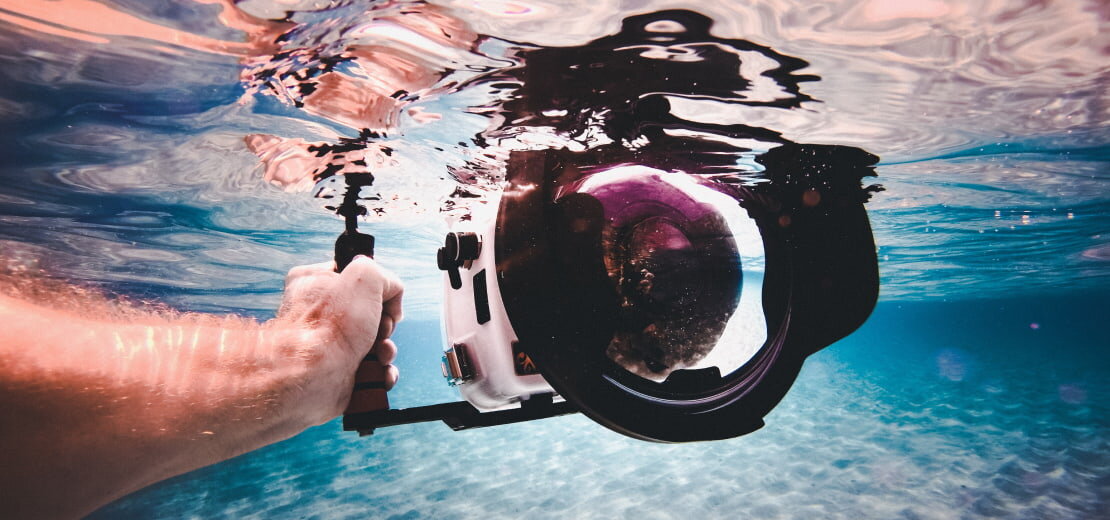
The Best Cameras for Scuba Diving Photography
In general, water has a very high density. The object of your camera can not always see all through the lens. Thus, consider the following nuances when choosing a camera:
- sensitivity;
- cost;
- the greatest allowed depth of immersion;
- the possibility of connecting external devices, such as a memory card and a monitor;
- viewing angle;
- battery life;
- availability of lighting;
- operating temperature range.
When choosing a camera, we recommend those whose sensitivity does not exceed 0.5 lux. So, keep the best cameras for scuba diving photography:
1. MARCUM LX-9+SONAR
The camera is the latest high-tech invention. It effectively combines the function of a high-resolution camera, sounder, and video recorder. The device is unique. It has an eight-inch display that allows you to enjoy the underwater world in all its glory. The screen displays the water's depth, direction, and temperature. During operation, the underwater camera set-up shows itself to be stable. It is also reliable and able to send data in two ways.
|
Advantages: |
Disadvantages: |
|
it perfectly combines cost and quality |
not found |
|
it is equipped with a powerful signal filter |
|
|
you can dive with it to a depth of about 22 meters |
|
|
it has the function of monitoring the underwater space |
|
|
it has clarity of photo and video recording |
2. PowerVision PowerRay
It is the world's first universal underwater drone. The device allows you to take photos, shoot videos and research various bodies of water. It has a built-in 4K UHD underwater camera set-up. You can handle the drone with the help of a control panel, diving to a depth of 30 meters for 4 hours at a speed of 3 knots. With the help of this unique device, you can get to places where divers can not.
|
Advantages: |
Disadvantages: |
|
it has an acceptable battery life |
it has a high cost |
|
it is a powerful built-in camera |
|
|
it has the chance of diving to a great depth |
|
|
it has the possibility of combining with virtual reality glasses |
3. Canon G12
It is a compact digital camera with underwater photography and video recording modes. So you don't have to worry about white balance. It's a G-series camera that offers wide-angle shooting with 5x (28mm) zoom. Besides, it has Hybrid IS image stabilization. Adding a 10-megapixel sensor and DIGIC 4 image processor ensures accurate image quality. This underwater photography technique allows you to shoot in RAW files.
|
Advantages: |
Disadvantages: |
|
it is straightforward to work with |
not found |
|
it has no problems with the white balance |
|
|
it has high-resolution frames |
Where Can You Conduct Underwater Photography Techniques?
Water is a broad concept. After all, the hydrosphere occupies 70% of the earth's surface. Thus, you have many options where you can conduct an underwater photo session. The most popular places for this are:
- Sea
Are you interested in coral reefs, colorful small fish, and algae? A sea is an ideal option for this. There you can take the most beautiful landscape photos of underwater beauty.
- Waterfall
The remarkable phenomenon of the waterfall allows taking incredible photos of it. You can photograph it on land, under the water, or even from above with a drone. If you want to do underwater photography, you will need to master specific techniques. After all, the intense water pressure of the waterfall causes particular difficulties.
- River and lake
Use the best special cameras for scuba diving photography. And with the help of this, you take pictures of fish. It is not always possible to get high-quality images because of the muddy water. But if you put in the effort, it will be interesting.
- Ocean
The ocean is like the sea, but many times more interesting. There is an opportunity to capture sharks, dolphins, and other sea creatures. In addition, you can take advantage of exciting water phenomena and make a beautiful shot. For example, take a photo of stormy waves or seashells under clear, calm water.
- Swimming pool
Such a place is an excellent option for an underwater fashion photo session. Models prepare outfits and lower to the bottom of the pool. At this time, photographers can conveniently organize an underwater camera set-up. The flat surface of the bottom of the pool makes it very easy to do this.
- Bath and jacuzzi
In such places, you can photograph either a model or take an object shot. It does not require a lot of special equipment, but photography skills should be high.
All these places are perfect for photography. And interestingly, each of these places is special in its way. For example, in the sea, you can take pictures of the landscape of coral reefs. And in the pool, you can create the most creative fashion photos for the model. You can take great pictures of anything. Just select the best settings for underwater photography.
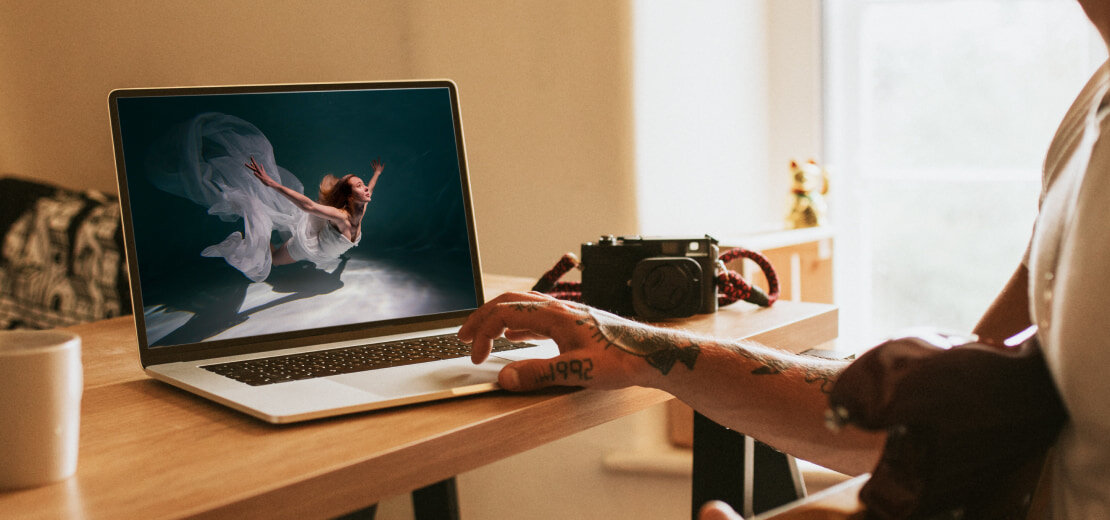
Basics of Underwater Photography Techniques
Before starting photography, know the basics of this business. It, like any activity, requires basic skills and knowledge. To begin this, you need to have some idea of the initial rules of the field. Find out which camera is better to choose, which swimming techniques to use, and all that. By learning about the basics, you can move further in this direction.
By studying them, you will find certain secrets on how to improve your work. So, you will expand your horizons in underwater photography techniques over time. And all because you will know the basics that are the foundation for successful professional work.
So, take your time to become a professional photographer right away. Start doing it gradually and learn the basics:
1. Learn to swim
Obviously, to take great pictures in the hydrosphere, you have to swim:
- It is unnecessary to do it professionally. But you should have at least the most minor skills for this.
- If you plan to shoot at great depth and take landscape shots, you should put in more effort.
- Start diving and breathe appropriately under the water. These lessons will help you work better and longer.
2. Check the weather
All the results of your underwater photo session depend on the weather conditions. So, before starting underwater photography and choosing techniques, check the weather:
- Obviously, if there has been a recent storm at sea, you are unlikely to capture coral shots. Because the water after such a phenomenon is muddy and very dense.
- Thus, if you are going to take pictures in the ocean, river, or sea, keep an eye on the weather forecast.
- The best weather is calm. And the best waters are salty. Their transparency is the best.
3. Practice before starting work
The main mistake of beginners is that they want everything at once. But you will not achieve the desired result until you practice:
- Thus, before starting underwater photography equipment, we recommend using it in practice for beginners.
- Study the structure of the camera.
- Understand the best settings for underwater photography. Setting up a shot underwater is very different from a photo on land.
- So experiment with exposure, contrast, and the like.
- You can start the main work by knowing what settings create good photos.
4. Analyze the shooting before it begins
Have you planned an underwater photo session? Have you thought about what results you want and what you will work with? It is imperative to consider these details before shooting:
- You should know under what conditions it will happen and what difficulties you can face.
- Such an organizational attitude to this process will help to achieve faster success.
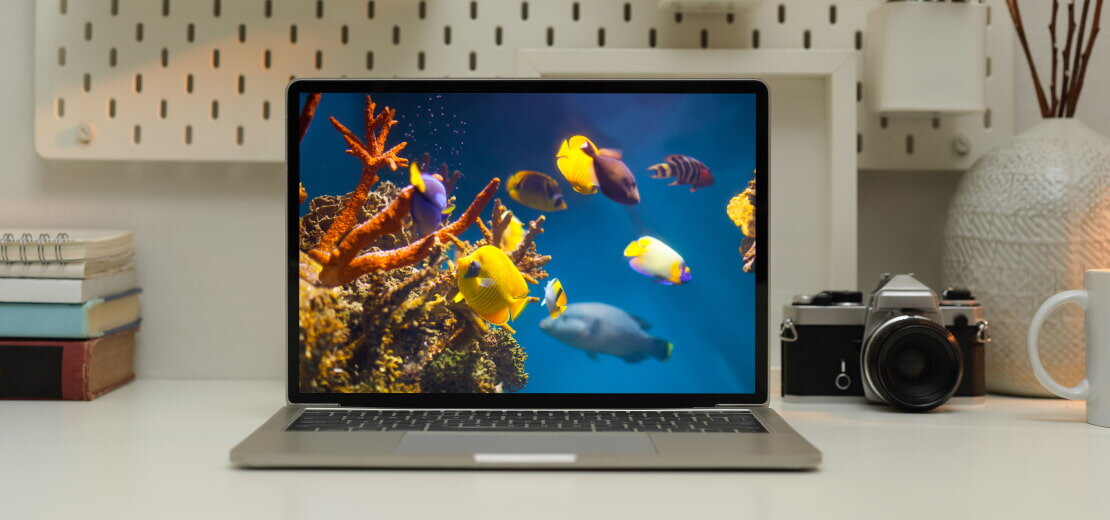
How to Edit Underwater Photographs
Not all photos can be of excellent quality. Sometimes they can have a lot of noise, not enough brightness or something extra. In such situations, you should have photo editing skills. Choose the best editing settings for underwater photography, and turn it into art. But the main thing is not to overdo it. There is no need to take photos that are too contrasting and artificial. They should be natural. Here's what you need to do to bring your underwater images to life:
-
Do the analysis
A crucial step in editing a photo is to study it. Analyze exactly what adjustments it needs. Think about what you like and how you can improve the image.
-
Restore the color of your underwater photos
The major step in editing is color correction. It is one of the best settings for underwater photography. If you shot in natural light and don't have lighting, your photo can have a blue hue. In these cases, underwater images need color correction. Adjust the temperature and tint of the image before continuing to edit it.
-
Adjust the exposure
Adjust it, if necessary. A handy tool for analyzing light in photographs is the histogram. It is the ideal approach to learn the photo's exposure and understand what is wrong.
-
Add contrast to your photos
One of the features of the underwater environment is that we lose light and contrast under the water. Objects appear more blurred and less sharp due to the density of the water. To avoid this, you need to give the underwater camera set-up contrast.
Contrast is the difference between dark and light in a photo. The bigger the difference, the more contrasty the picture, and vice versa.
-
Add clarity
It doesn't matter what underwater photography techniques you use. The clarity in such photos is almost always far behind. It is primarily due to the turbidity of the water.
Thus, further in the editing, you need to add clarity to the photo. It provides contrast in the light and shadow areas of the image. And also it makes textures more contrasting.
-
Add shadows or light
Reduce highlights when editing your underwater photos. If there is an area with excess light, remove it, and you will get a pure white color. This way, you can restore the details of that part of the photo that was too bright.
And with the help of the shadow tool, adjust the dark areas of the picture. If an area is too dark but not completely black, increase the shadows slightly. This way, you can restore details and textures with the help of such underwater photography techniques.
-
Edit saturation
The problem with which the photo can lack saturation is not using the flash when taking pictures. In other words, the loss of colors occurs due to light absorption. The density of water creates it. So, when editing underwater photos, add some saturation. It will help emphasize the color of the image.
-
Remove unnecessary items
Sometimes you can not notice how something extra fits into your frame. And then, when viewing the photo, you realize that it spoiled the picture. In such cases, you should not be upset. The best camera programs for scuba diving photography have tools to remove blemishes.
If there are extra small elements, dark spots or flash marks in the frame, you can remove them. The main thing is not to edit it too much so it looks natural.
-
Adjust the focus
Use focus to highlight details in an image or locally in a specific object. You should use it with great care and in moderation. If it is high, unwanted noise will appear in the image. Accordingly, it will lead to poor quality.
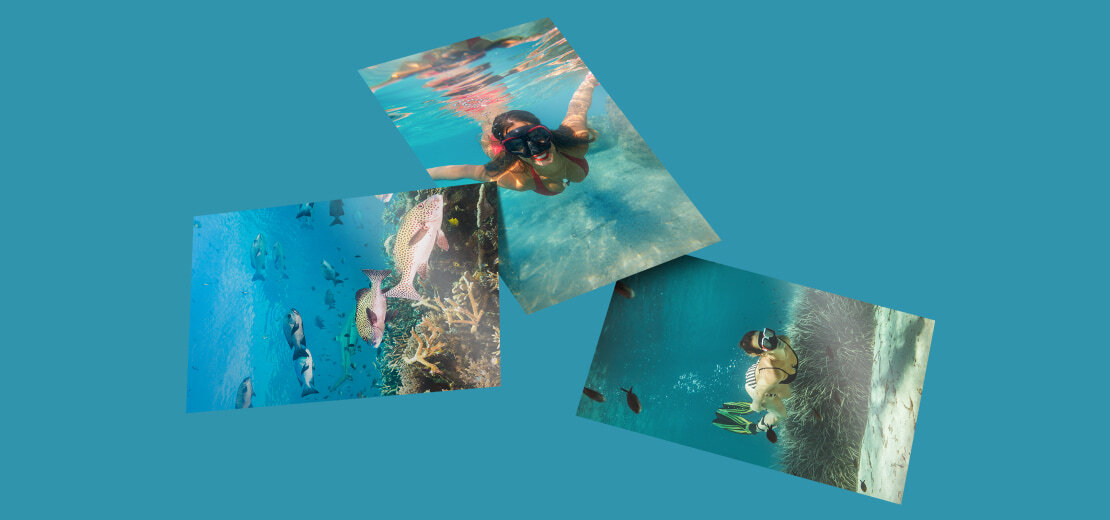
Underwater Photography Techniques Tips
Whatever your occupation, if you are a beginner, you probably need help and some advice. And this applies to the field of underwater photography. When you start practicing and try to take the first shots, you realize that you don't know much yet. And even if you have the best camera for scuba diving photography, the result can be unsuccessful. Why?
Because the quality of the photo depends not only on the model of your camera. Along with this, you should ideally use its functions and be able to work in any conditions with water.
Besides this, you should discover certain secrets in working with it. Many professionals get excellent results thanks to the subtleties they learn over years of experience. And to make your way to the area of underwater photographs easier, we have prepared some tips for you. They will help you succeed faster and understand the details more easily:
-
Try to use more light
When you do an underwater camera set-up, use extra lighting. But use it at an angle above the object. Why at an angle? Because in this position, the light does not illuminate the lens. Accordingly, the photos are of better quality.
-
Never give up too quickly
We know that it is challenging to work underwater due to unusual conditions. But good results can be only through persistence and patience. So, if the camera loses focus or something doesn't work out for you, don't give up. It is better to try changing the perspective and using the best underwater photography settings.
-
Do test work
Before taking pictures in the ocean, try taking a couple of images in the pool. So you will have a broader concept of how it works under the water. And you will learn to use extra underwater photography equipment for beginners.
-
Hold the camera steady
Holding a camera underwater is a test for everyone because water is always in motion. Thus, familiarize yourself with the water before starting the shooting.
-
Remember camera settings
Try to remember approximately what settings you use when shooting. This way, you will make underwater photography set-up easier and faster:
- We recommend using a lower ISO. It lets you get a photo with the least amount of noise.
- As for the shutter speed, set it to about 1/125 - 1/500 seconds.
- Use an aperture of f/11-f/20, clearing objects in the foreground and background.
If possible, shoot in RAW format. This will allow you to make color corrections later.
-
Use zoom for details
Underwater macro photography can produce great results. And even if you do not plan to do this type of shooting, the zoom will not be excessive. Maybe you will see something exciting under the water. So macro shooting will create amazing shots with these underwater cameras set-up. Use 50mm - 200mm attachment lenses to focus on objects a few centimeters away from the lens.
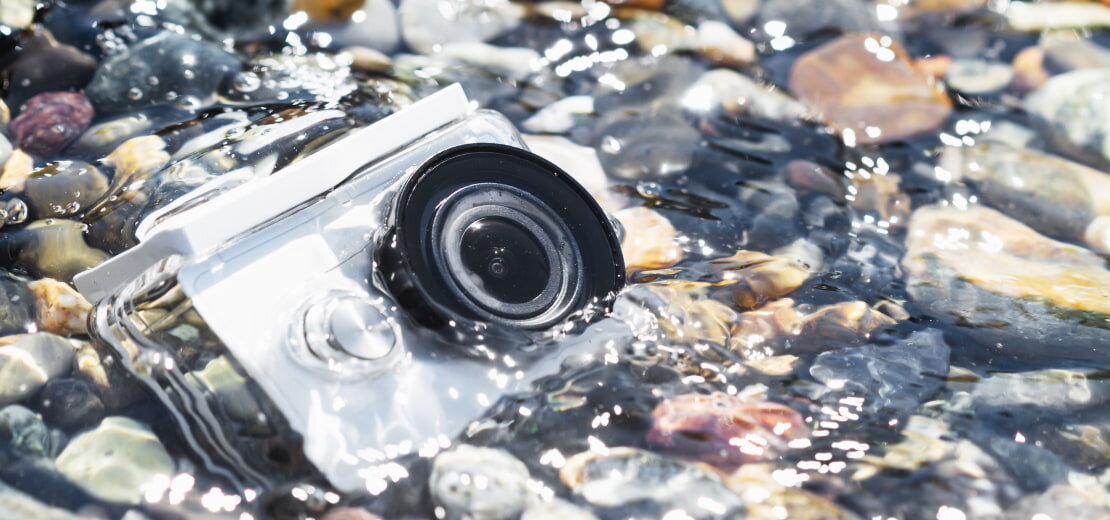
First-Time Advice For Underwater Photographers
If you shoot this genre for the first time, you probably need help. After all, when you study theory, it's one thing. But when it comes to practice, many new tasks appear. So, if you are ready to go into underwater photography, here are tips for you on how to do this step by step:
- Charge your work equipment and test it to ensure it's working. Close the camera body tightly to prevent moisture from getting inside. Besides, perform underwater camera set-up.
- When you dive into the water, determine the stable position of the body. Control the position of your hands in which you hold the camera. It is essential to balance the body and be able to swim correctly.
- To begin, take a couple of pictures from only one angle. If the results are not great, change the angle. You should find where your photos will get the best colors and quality.
- Next, consider the distance from you to the shooting object. The optimal space for shooting things is 1 - 2 meters. Increasing the shooting distance can distort the object depicted in the picture. Or it can create a motion blur subject in the frame.
- If you want to capture as many objects as possible in the photo, turn on the wide-angle mode. For this, it is unnecessary to have the best camera for scuba diving photography. But the lens should be good so that the pictures are high-quality.
- Next, you need to turn on the flash if you are within 2-3 feet of the subject. Turn off the flash if it is more than 3 feet away. It can make your photo results look blue and blurry.
- Remember, the closer you are to the object, the better the photos. Accordingly, always place the thing in your lens as close as possible.
- For the color scheme in the pictures to be realistic, set the best settings for underwater photography. It applies to white balance and exposure.
- If you can not adjust the focus and it keeps losing, try holding down the shutter button. This will fix a specific position, and you can focus on the desired object.
- After the underwater shooting, pay attention to camera care. Rinse the equipment with clean water and dry it thoroughly. Before opening the case of the device, make sure that there is no water left in it.
Organize shooting in the first half of the day to get the most vivid and clear pictures. At the same time, the day should be sunny and clear. If it is bad weather there, use more lighting. It will ensure the quality of the received photos.
Create Your Photography Portfolio Website
Photos that people create underwater are a real art behind which there is a lot of effort. This genre of photography requires a lot of knowledge, practice, and patience. But thanks to modern underwater photography techniques, it is a little easier.
The main thing is to correctly decide on the equipment and be able to use it. After you create your underwater collection of works, you will need to make a portfolio. You can do this very easily using our Portfoliobox website builder.












